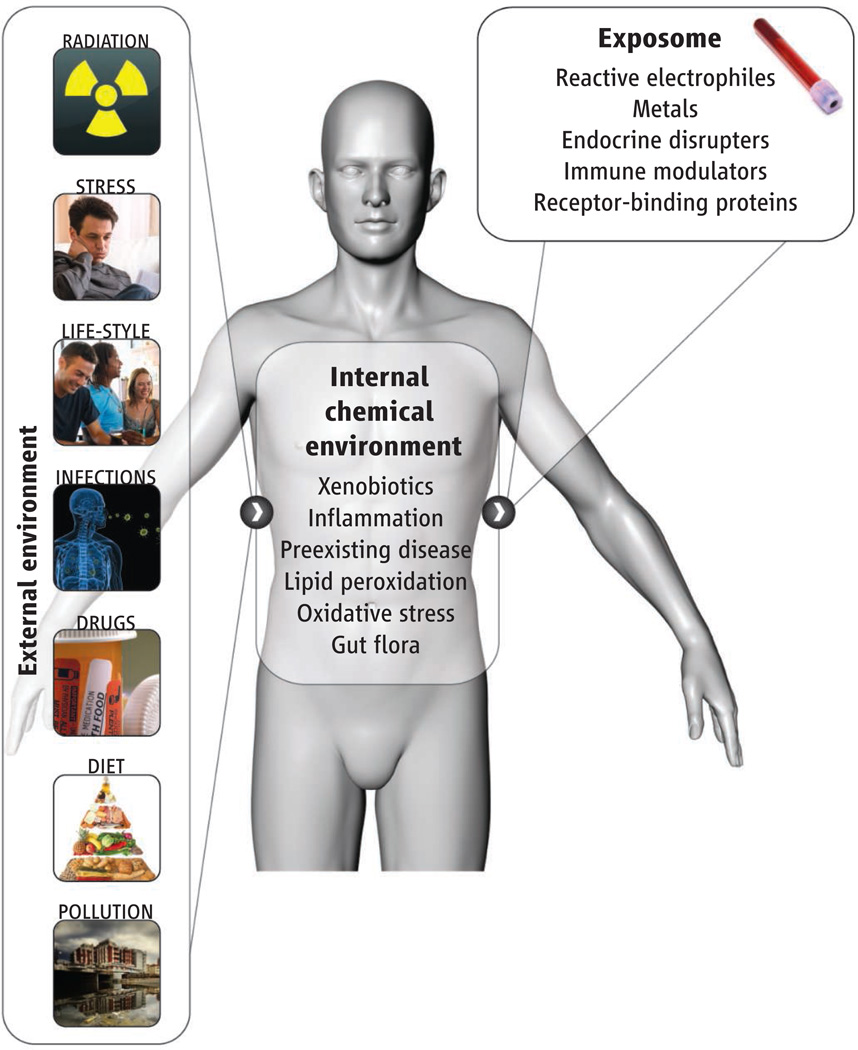The Exposome Collaborative Background
Background

The exposome encompasses the totality of human environmental (i.e., non-genetic) exposures, both internal and external, from conception to death, complementing the genome. It includes measuring the cumulative imprint of environmental influences and associated biological responses throughout the lifespan, including exposures from the environment, diet, behavior, and endogenous processes (1-5).
In a holistic way the exposome (Fig. 1) encompasses: 1) a life-time internal exposome including the microbiome, inflammation, and processes such as oxidative stress and lipid peroxidation, 2) the underlying external exposures such as environmental chemical, physical, and biological contaminants arising from indoor and outdoor environments, including occupation and lifestyle factors, and 3) the social, economic, ecological, and psychological factors that can affect chronic diseases (6). This integrative approach, combining untargeted approaches with targeted validation, requires a range of tools and techniques to capture the different domains of the exposome (Fig. 1).
Many of these tools are already mature for deployment in community health studies, while others still require development. The last decade has seen rapid strides in various “omics” technologies to characterize downstream biological events in terms of profiles of hundreds or thousands of metabolites (metabolomics), proteins (proteomics), adductomics, immunomics, RNA expression (transcriptomics), histone modification and methylation profiles and micro- and other non-coding RNAs (epigenomics). Equally rapid development of material sciences and electronic technologies has enhanced our ability to measure and map exposures. These include, for example, sensors that measure a wide range of environmental pollutants, monitors for physiological parameters (i.e. blood pressure, heart rate, stress, physical activity, sleep patterns), GPS devices for monitoring location, mobile phones for dietary assessments and social interactions, and high resolution atmospheric models for predicting ground level pollutant levels, as well as high resolution mass spectrometry and deep sequencing, for adducts, and metabolic and epigenetic imprints.
The ultimate goal is to understand the qualitative and quantitative relationships between exposures and their socio-demographic determinants and the profiles determined by the omics techniques. The challenge lies in the integrated analysis and statistical modeling of all the big data sets generated. Here we highlight five exposome papers that help introduce the topic from its initial formulation and through this evolving field to where it stands today. After reviewing these papers, the reader should have a firm sense of what the exposome encompasses and how investigators in the field of environmental health sciences view the approach to tackling the questions presented. As always in research, the field will continue to grow with new research and scientific dialogue around the exposome.
References
- Wild CP. Complementing the genome with an "exposome": the outstanding challenge of environmental exposure measurement in molecular epidemiology. Cancer epidemiology, biomarkers & prevention: a publication of the American Association for Cancer Research, cosponsored by the American Society of Preventive Oncology. 2005;14(8):1847-50. Epub 2005/08/17. doi: 10.1158/1055-9965.EPI-05-0456. PubMed PMID: 16103423.
- Wild CP. Environmental exposure measurement in cancer epidemiology. Mutagenesis. 2009;24(2):117-25. Epub 2008/11/27. doi: 10.1093/mutage/gen061. PubMed PMID: 19033256 PMCID: PMC2720689.
- Wild CP. Future research perspectives on environment and health: the requirement for a more expansive concept of translational cancer research. Environmental health: a global access science source. 2011;10 Suppl 1:S15. Epub 2011/04/16. doi: 10.1186/1476-069X-10-S1-S15. PubMed PMID: 21489211 PMCID: PMC3073193.
- Rappaport SM, Smith MT. Epidemiology. Environment and disease risks. Science. 2010;330(6003):460-1. Epub 2010/10/23. doi: 10.1126/science.1192603. PubMed PMID: 20966241 PMCID: PMC4841276.
- Wild CP. The exposome: from concept to utility. International journal of epidemiology. 2012;41(1):24-32. Epub 2012/02/03. doi: 10.1093/ije/dyr236. PubMed PMID: 22296988.
- van Tongeren M, Cherrie JW. An integrated approach to the exposome. Environmental health perspectives. 2012;120(3):A103-4; author reply A4. Epub 2012/03/03. doi: 10.1289/ehp.1104719. PubMed PMID: 22381920 PMCID: PMC3295361.
IMAGE CREDIT: N. KEVITIYAGALA/SCIENCE
Contact Us
Fenna Sillé, PhD
fsille1@jhu.edu
